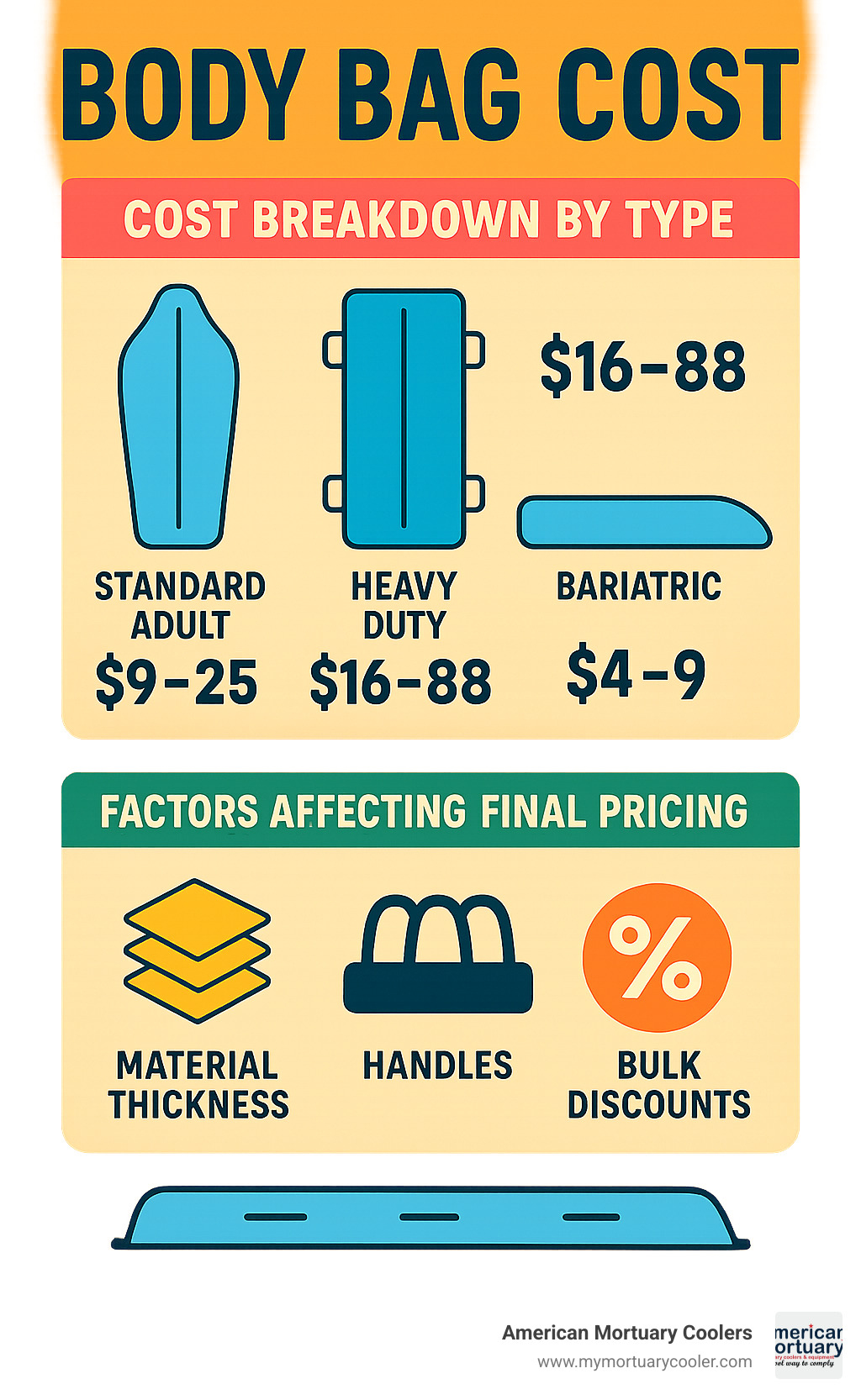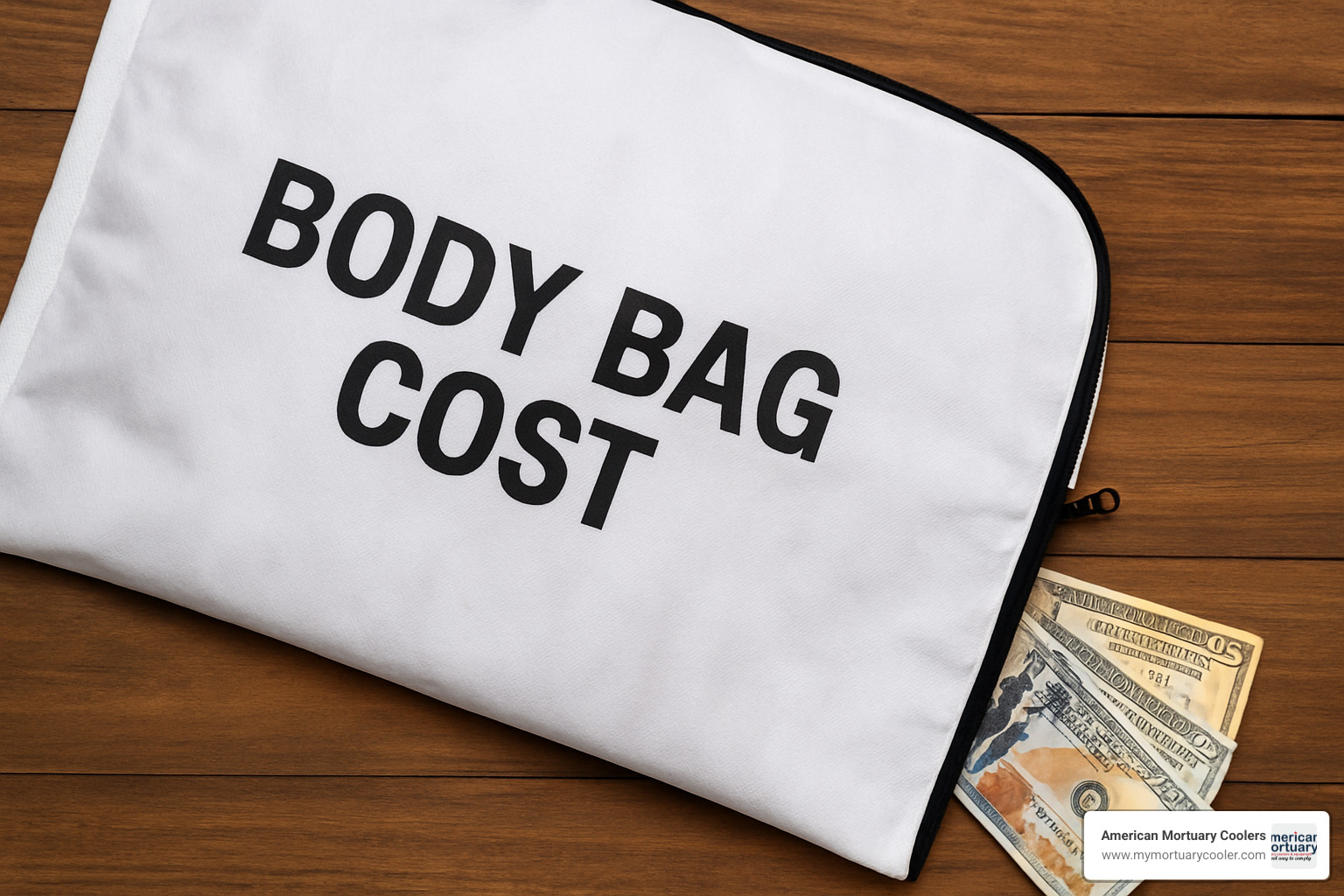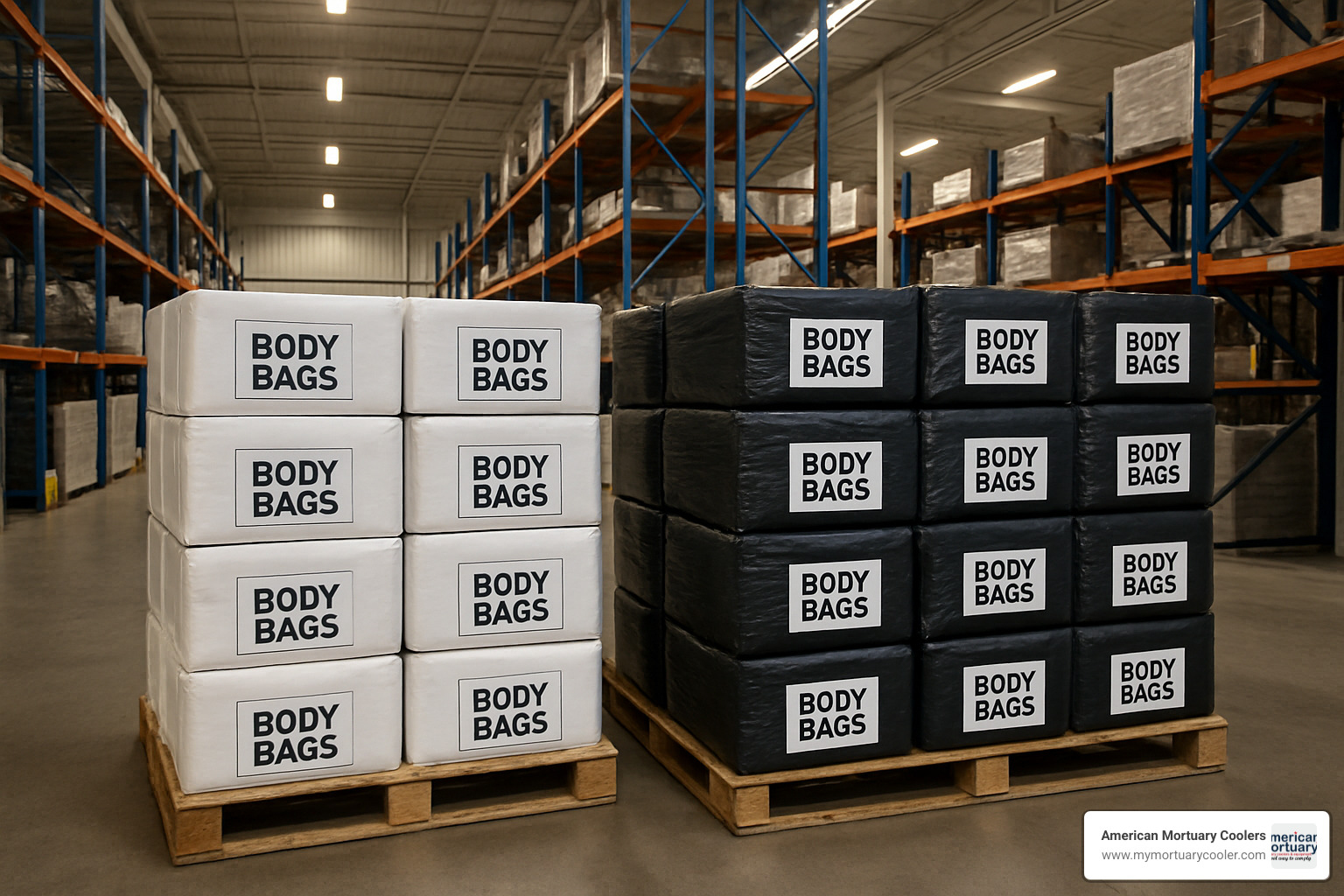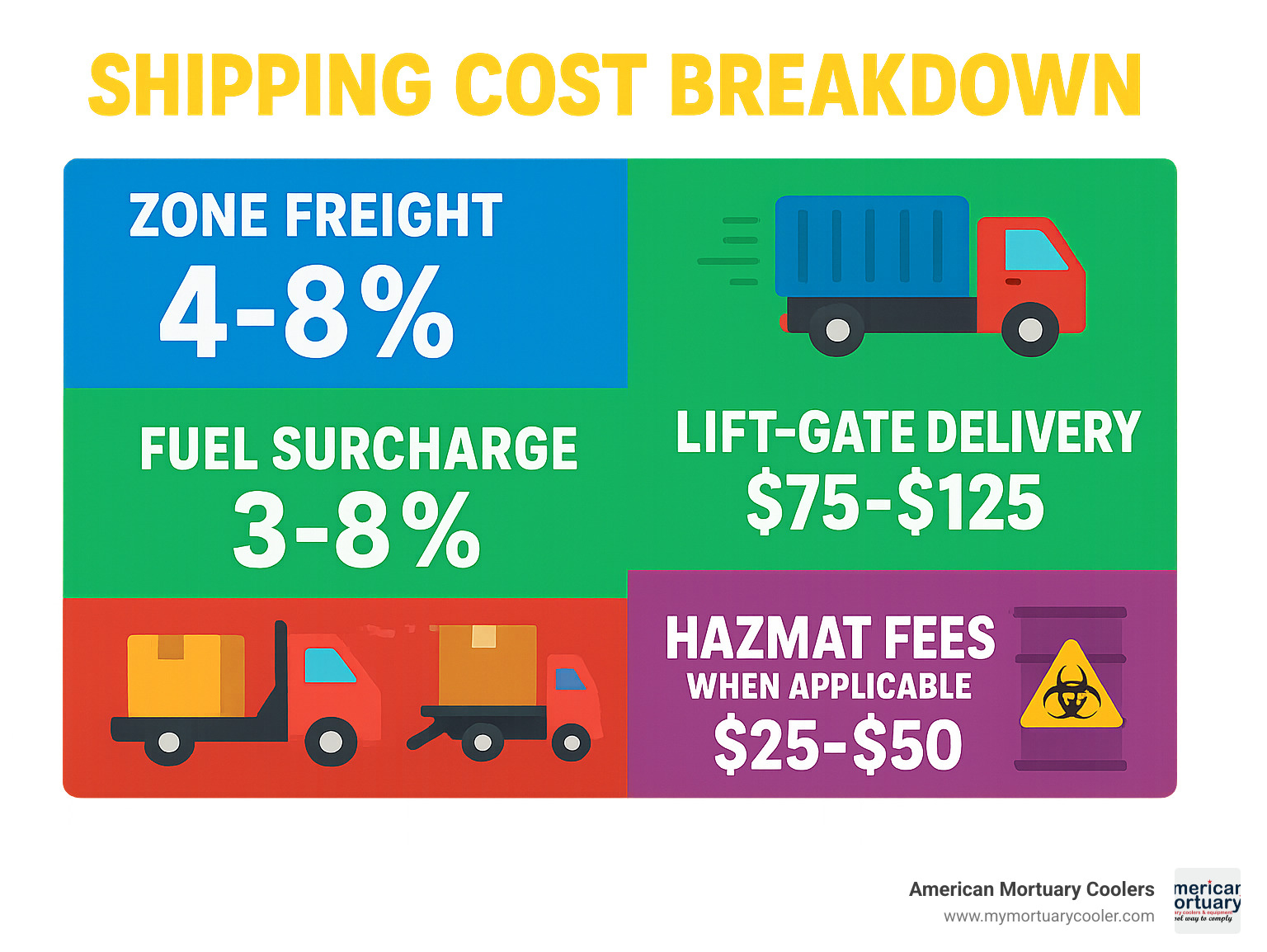Understanding Body Bag Pricing in Today's Market
Body bag cost varies significantly based on type, materials, and features, but here's what funeral directors and medical facilities can expect to pay:
Quick Price Reference: - Standard Adult Bags: $8.99 - $25.51 per bag (cases of 10-25) - Heavy Duty/Reinforced: $15.60 - $87.64 per bag - Bariatric/Oversized: Up to $110 per bag - Pediatric/Infant: $3.99 - $8.65 per bag - Specialty (Water Recovery, Bio-Seal): $25 - $75 per bag
The funeral industry has seen dramatic shifts in body bag pricing over recent years. During COVID-19, demand surges created supply shortages that pushed prices higher. Now in 2024, the market has stabilized, but understanding what drives body bag cost remains crucial for budget planning.
Whether you're stocking for routine removals or preparing for disaster response, material thickness (measured in mils), handle count, zipper style, and duty rating all impact pricing. Bulk purchasing can reduce per-unit costs by 15-30%, making case orders the standard for most funeral homes and medical facilities.
As American Mortuary Coolers, we've spent years helping funeral directors steer mortuary equipment procurement, including analyzing body bag cost trends across different suppliers and specifications. Our experience has shown that understanding these price factors upfront prevents budget surprises and ensures you get the right products for your needs.

Body Bag Cost 101: Average Prices & Key Factors
When funeral directors ask us about body bag cost, the first thing we explain is that it's not just about the sticker price. Think of it like buying a car – a basic model gets you from point A to point B, but you'll pay more for premium features.
The biggest factor driving body bag cost is material thickness, measured in "mils." Standard bags use 6-8 mil PVC, which works fine for routine transport. But if you need something for disaster response or challenging conditions, you're looking at 18-22 mil vinyl-coated materials that can handle much more stress.
Standard adult body bags typically run $8.99 to $25.51 per bag when you buy them in bulk cases. That range can stretch much wider once you start adding specialty features.
Material choice makes a real difference in your budget. High-density virgin PVC costs more than recycled materials, but it won't let you down when you need puncture resistance and leak-proof performance. PEVA materials cost even more because they're cremation-friendly and chlorine-free. Some facilities prefer heavy-duty tarpaulin construction for its strength, but expect to pay premium prices.
Handle configuration is another cost driver. Basic bags with no handles start at the lower price range, while bags with 6-12 reinforced handles can add $15-30 to your per-unit cost. Most customers prefer padded handles over strap handles – nobody wants straps cutting into their hands during transport.
Zipper style affects both performance and cost. Center zippers cost less than envelope-style zippers, but envelope zippers give you better leak resistance. Heavy-duty dual-pull zippers with locking mechanisms add $2-5 to the base cost.
USA-made products consistently cost 20-40% more than imported alternatives. During COVID-19, though, domestic suppliers proved their worth when international supply chains got disrupted.
| Duty Rating | Thickness | Price Range | Key Features |
|---|---|---|---|
| Light Duty | 6-8 mil | $8.99-$12.00 | Basic transport, curved zipper |
| Medium Duty | 10-12 mil | $10.86-$16.00 | Reinforced scrim, envelope zipper |
| Heavy Duty | 15-22 mil | $25.51-$87.64 | Multiple handles, leak-proof seams |
Standard Adult Body Bag Cost Breakdown
Most funeral homes want to know about body bag cost for standard adult bags – the bread and butter of mortuary transport. These bags typically measure 36" x 90" or 38" x 90" and use 8 mil high-density PVC construction.
A standard 8 mil body bag runs about $97.50 per case of 10 bags, which breaks down to $9.75 per bag. For that price, you get reinforced curved zippers with dual rust-proof pulls and locking loops, heat-sealed seams that are 100% leak-proof, and usually three toe tags for identification.
The construction details matter here. You're getting white embossed high-density virgin PVC material that provides durability and fluid containment. All seams are electronically heat-sealed to meet OSHA Regulation 3130 for bodily fluid containment. The 400-pound weight capacity handles standard adult transport requirements.
Heavy Duty & Bariatric Body Bag Cost
Heavy-duty and bariatric body bags sit at the premium end of the body bag cost spectrum, with prices ranging from $25.51 for reinforced standard bags up to $110 for specialized bariatric models.
The Super Heavy Duty Military Grade Body Bag shows what premium pricing looks like – $87.64 per piece when you buy cases of five. These bags use heavy-duty vinyl-coated nylon scrim construction, measure 38" x 94", and support up to 1,000 pounds. They're built to US Military Standard MIL-P-1080F and designed for extreme conditions, including helicopter transport under heavy wind loads.
Bariatric bags command the highest prices because of their specialized construction and larger dimensions. These oversized bags can cost up to $110 each and typically feature 16 strap handles for safe multi-person lifting. The envelope zipper design with grommets lets the internal volume double when needed for larger individuals.
The price premium for heavy-duty construction reflects several factors: thicker materials (18-22 mil vs. 8 mil standard), reinforced handle systems with 900+ pound tensile strength, improved zipper systems with metal components, and compliance with military or government specifications.
Compare Prices by Duty Rating & Specialized Type
When shopping for body bags, you'll quickly find that not all bags are created equal. The body bag cost varies dramatically based on what you're planning to use them for, and understanding these differences can save you money while ensuring you get the right protection for each situation.

Think of body bags like cars – you wouldn't use a compact car to haul construction materials, and you don't need a heavy-duty truck for daily commuting. The same logic applies here. Light-duty bags work perfectly for routine transport from hospitals to funeral homes, while heavy-duty disaster pouches are built for challenging conditions like natural disasters or mass casualty events.
The color-coding system helps identify different bag types quickly. FEMA-blue bags are specifically designed for disaster response and typically cost more than standard black bags due to their specialized construction and government compliance requirements. Black heavy-duty bags represent the premium option for extreme conditions, while mesh water recovery bags serve the specialized need for aquatic recoveries.
Cremation-friendly bags deserve special mention because they use chlorine-free PEVA materials instead of standard PVC. While they cost 20-30% more than regular bags, they eliminate toxic gas concerns during cremation – a crucial consideration for funeral homes offering cremation services.
For situations requiring specialized disaster response equipment, you might want to check out our detailed comparison in Disaster Pouch vs Body Bags to understand which option works best for your specific needs.
Light vs Medium Duty Price Spread
The jump from light-duty to medium-duty bags might seem small – we're talking about a $2-6 price difference per bag – but the performance improvement is substantial. Light-duty bags at $8-12 each handle routine transport just fine, but medium-duty bags at $10-16 each offer significantly better tear resistance and durability.
The secret lies in the reinforcement scrim layer that medium-duty bags include. This internal mesh reinforcement prevents the kind of tears and punctures that can turn a simple transport into a serious problem. It's like the difference between a regular trash bag and a contractor-grade bag – both hold things, but one handles stress much better.
Zipper configuration also affects pricing between these categories. Light-duty bags typically use center zippers, which are cheaper to manufacture but adequate for basic needs. Medium-duty bags often feature envelope-style zippers that wrap around the bag opening, providing better leak resistance and security.
For most funeral homes handling regular caseloads, medium-duty bags offer the sweet spot between cost and performance. The modest price increase over light-duty options pays for itself in reliability and peace of mind during transport.
Specialty & Military-Spec Bag Pricing
Military-specification bags represent the premium end of the market, and their pricing reflects the extreme performance requirements they're designed to meet. When you see a DoD NSN 9930-01-331-6244 specification bag priced at $75-88 each, you're paying for engineering that can handle helicopter transport operations and extreme field conditions.
These bags use 18 mil construction – more than double the thickness of standard bags – and feature six reinforced handles with tensile strengths exceeding 900 pounds. The envelope-style zippers include locking mechanisms for security, and every component is built to withstand conditions that would destroy standard bags.
The helicopter lift strength requirement isn't just military jargon – it means these bags can handle the wind loads and stress of being lifted by aircraft without failing. For disaster response teams and military operations, this reliability justifies the premium body bag cost.
During crisis situations like COVID-19, some suppliers modified their production methods to meet demand while maintaining performance standards. These adaptations sometimes affected pricing temporarily, but they demonstrated how the industry responds to urgent needs while keeping quality standards high.
For more insights into how supply chain factors affect specialty bag pricing, you can explore Scientific research on supply chain resilience to understand the broader market dynamics at play.
Single vs. Bulk Purchasing, Shipping & Market Trends
The body bag cost landscape has shifted dramatically over the past few years, and understanding these changes can save your facility thousands of dollars annually. We've watched funeral homes and medical facilities steer everything from pandemic shortages to the current stabilized market.

The most eye-opening trend we've observed is how purchasing patterns have evolved. During COVID-19, facilities that had always ordered single bags suddenly found themselves scrambling for inventory. Those who had adopted bulk purchasing weathered the storm much better, both in terms of availability and cost control.
Case quantities vary significantly across product types. Standard bags typically come in cases of 10, while heavy-duty disaster bags often ship in cases of 5 due to their weight and size. Pediatric bags may come in cases of 25.
The market has largely stabilized in 2024, but we're seeing permanent changes in how facilities approach inventory management. Disaster stockpiling has become standard practice rather than an exception, with government agencies and healthcare systems maintaining larger buffer stocks than pre-pandemic levels.
For facilities new to online purchasing, our Step-by-Step Guide to Buying Body Bags Online walks through the entire process, from specification selection to delivery scheduling.
Bulk Order Body Bag Cost Advantages
The body bag cost difference between single units and bulk orders is often shocking to newcomers in the industry. A single PVC body bag might cost $23.21, while that same bag drops to $8.99 when purchased in a case of 25. That's a 61% savings just for buying in reasonable quantities.
The tiered pricing makes sense from a supplier perspective. Processing one order for 25 bags costs roughly the same as processing an order for one bag, so suppliers pass those efficiencies along to customers who buy smart.
Hospital contracts and institutional agreements take this concept even further. Large healthcare systems often negotiate annual contracts with guaranteed volumes in exchange for pricing that goes beyond standard case discounts.
FEMA grants and disaster preparedness funding have opened new opportunities for bulk purchasing, particularly for government agencies and qualifying healthcare facilities. These programs recognize that pre-positioning inventory at favorable pricing improves emergency response while reducing taxpayer costs over time.
The economics extend beyond the obvious per-unit savings. Bulk purchasing reduces administrative overhead since you're processing fewer orders throughout the year.
Shipping & Handling Impact on Body Bag Cost
Transportation costs are the hidden factor that can significantly impact your total body bag cost, typically adding 7-12% to your order value. We've seen facilities get surprised by freight charges that weren't factored into their budgets.
Zone-based freight pricing means your distance from distribution centers directly affects shipping costs. A facility in Tennessee might pay significantly less for freight than one in Montana, simply due to geography.
Lift-gate delivery requirements add $75-125 to shipments when your facility lacks a loading dock. Most funeral homes and smaller medical facilities need this service, so factor it into your cost comparisons when evaluating suppliers.
Fuel surcharges fluctuate with diesel prices and can add 3-8% to freight costs during periods of high fuel prices. Some suppliers build these into their base pricing, while others itemize them separately.
Hazmat fees may apply to certain specialized body bag types, particularly those with chemical treatments or unique materials. Most standard PVC and vinyl bags don't require hazmat handling, but specialty products can incur additional fees of $25-50 per shipment.

The key takeaway? Always request delivered pricing when comparing suppliers. A supplier with slightly higher product costs but lower freight charges might offer better total value, especially for facilities requiring lift-gate delivery or located in remote areas.
Special Features, Accessories & Hidden Costs
When you're budgeting for body bags, the sticker price is just the beginning. We've seen plenty of funeral directors get surprised by add-on costs that can push their body bag cost well beyond initial estimates. Let's walk through what you might encounter so you can plan accordingly.

The biggest feature upgrade most facilities consider is handle configuration. You'll pay more for comfort here - basic strap handles might save money upfront, but they dig into your hands during transport. Padded handles cost an extra $2-6 per bag, but ask anyone who's done a removal and they'll tell you it's worth every penny.
Zipper quality makes a real difference in performance and cost. Standard center zippers keep costs down, but envelope-style zippers that wrap around the bag add about $1-3 to your body bag cost. The extra expense pays off in leak protection - something you definitely don't want to skimp on.
If you're working with crematoriums, cremation-friendly PEVA materials will add $3-5 to each bag compared to standard PVC. These chlorine-free materials eliminate toxic gas concerns during cremation, making them worth the premium for facilities that regularly coordinate with crematoriums.
For water recovery operations, mesh construction adds $10-15 to standard pricing. It's a specialized need, but when you need it, nothing else will do the job properly.
The material thickness you choose dramatically impacts pricing. Moving from basic 8 mil to heavy-duty 12 mil construction typically adds $2-4 per bag. Jump to premium 18-22 mil materials and you might double your base costs - but you'll get bags that can handle extreme conditions.
For detailed information about premium construction options, check out our Complete Guide to Heavy Duty Body Bags.
How Features Change Body Bag Cost
Every upgrade has its price, and understanding these costs helps you make smart decisions about which features matter most for your operations. Handle systems represent the most common upgrade, with reinforced multi-handle configurations adding $2-6 to your base body bag cost depending on how many handles you need and their construction quality.
Advanced zipper systems follow predictable pricing patterns. Dual-pull zippers with locking mechanisms cost more than basic single-pull versions, but they provide security benefits that matter for chain of custody requirements. Expect to pay $1-5 extra for these premium closure systems.
Material treatments can add significant costs depending on what you need. Antimicrobial treatments might only add $1-2 per bag, but specialized chemical resistance coatings can tack on $5-10 to your base price. The key is understanding which treatments actually benefit your specific use cases.
Specialized materials like heavy-duty vinyl-coated nylon or reinforced tarpaulin construction command premium pricing because they require different manufacturing processes and higher-grade raw materials. These upgrades make sense for disaster response or challenging transport conditions, but they're overkill for routine removals.
Accessory Add-Ons to Budget For
The accessories can add up quickly if you're not paying attention. Disposable liners cost about $1.25 each but make cleanup much easier and can actually extend the life of reusable bags. Many facilities find them worth the extra expense for the convenience factor alone.
Absorbent pads at $0.80 each help manage fluid issues during transport. They're particularly valuable for longer drives or cases where you're dealing with significant fluid concerns. Think of them as insurance for your vehicle and equipment.
ID tags are usually included with bags, but additional tags cost about $0.15 each if you need extras for complex identification requirements. Most bags come with 2-3 tags standard, which handles most situations.
Body cart covers run about $15 each and provide discrete transport while protecting bags from contamination. They're especially important if you're moving through public areas or have multiple transport routes where appearance matters.
Safe-Seal heat systems represent a bigger investment, with replacement rolls costing $200-400. However, these systems can actually reduce your long-term body bag cost by letting you create custom-sized bags and reduce waste from oversized bags.
The reality is that these accessories often become necessities once you start using them. Budget for the ones that make your operations smoother and safer - your staff will appreciate the investment.
Frequently Asked Questions about Body Bag Cost
Why are USA-made body bags often pricier than imports?
When funeral directors ask us about pricing differences, this question comes up constantly. Body bag cost for USA-made products runs about 20-40% higher than imports, and there are solid reasons behind this gap.
The biggest factor is labor costs. American workers earn significantly more than their counterparts in countries like China or Vietnam where most imported bags originate. But you're not just paying for higher wages - you're getting better quality control and consistency.
USA manufacturers must comply with strict OSHA regulations, environmental standards, and workplace safety requirements. These add real costs to production, but they also ensure the products meet higher safety standards for the people handling them daily.
Here's something interesting we learned during COVID-19: while imported bags seemed cheaper upfront, domestic suppliers proved far more reliable when international supply chains collapsed. Many funeral homes that relied solely on imports found themselves scrambling for inventory when they needed it most.
Transportation costs actually favor domestic production for bulk orders. International shipping can tack on 10-15% to your total costs, plus import duties and customs fees. When you factor in these hidden costs, the price gap narrows considerably.
The quality consistency we see with USA-made bags typically means fewer defective products and less waste. For most funeral homes, that reliability is worth the premium.
What's the cost difference between disposable and reusable body bags?
This question usually comes from funeral directors looking to control costs, and we understand the thinking. Disposable bags cost $8-25 each, while heavy-duty reusable bags run $75-150 each. At first glance, reusable seems like the smart financial choice.
But here's where the math gets tricky. Professional decontamination services charge $15-25 per cleaning cycle. If you clean in-house, you need specialized chemicals, equipment, and staff time. Most facilities find that cleaning costs exceed any savings after just 3-5 uses.
The bigger concern is liability. Cross-contamination risks and potential regulatory violations make single-use bags the safer choice legally and operationally. We've seen funeral homes struggle with state inspectors over reuse protocols that weren't properly followed.
Body bag cost calculations change dramatically when you factor in labor for cleaning, storage space for dirty bags awaiting cleaning, and the administrative burden of tracking use cycles. Most funeral directors tell us that disposable bags actually save money when all factors are considered.
There are exceptions. Military operations or remote locations where disposal is challenging might justify reusable options. But for typical funeral home operations, disposable bags offer the best combination of cost-effectiveness and peace of mind.
Do funeral homes get special discounts on bulk body bag orders?
Absolutely, and this is one area where funeral homes have real advantages. Industry-specific distributors understand your unique needs - seasonal variations, emergency response requirements, and the challenge of predicting inventory needs.
Bulk purchasing typically reduces body bag cost by 15-30% compared to single-unit pricing. But funeral homes can often access additional discounts through annual contracts or guaranteed volume commitments. We've seen funeral homes lock in favorable pricing for entire years, providing budget predictability.
Cooperative purchasing programs offer smaller funeral homes a smart way to access bulk pricing without carrying huge inventories. By combining orders with other facilities, you can access institutional pricing that would normally require much larger individual orders.
Government programs sometimes provide additional opportunities. FEMA grants and emergency preparedness funding can support bulk purchasing programs, especially for funeral homes that serve as disaster response partners in their communities.
The key is building relationships with suppliers who understand the funeral industry. They know you might need emergency inventory during flu season or natural disasters, and they structure their programs accordingly. Don't be afraid to negotiate - most suppliers prefer the predictable revenue that comes with funeral home partnerships.
Conclusion
When it comes to body bag cost, there's a lot more to consider than just the sticker price. We've walked through everything from material thickness and handle types to bulk discounts and shipping fees – and honestly, it can feel overwhelming at first.
But here's what we've learned after years of helping funeral directors across Tennessee, Atlanta, Chicago, Columbia, Dallas, Los Angeles, New York, Pittsburgh, and throughout the country: smart planning beats penny-pinching every time.
At American Mortuary Coolers, we've seen too many facilities get caught off guard by emergency orders at premium prices, or worse, compromise on quality to save a few dollars only to face problems during transport. The sweet spot is understanding exactly what your facility needs and buying accordingly.
The biggest money-saver? Bulk purchasing. Those 15-30% savings from buying cases instead of single units add up fast. A standard bag that costs $23 individually drops to under $9 when you buy a case – that's real money back in your budget.
Don't over-specify, but don't cut corners either. Heavy-duty military-grade bags at $87 each might be overkill for routine removals, but basic 6-mil bags won't hold up if you're dealing with challenging transport conditions. Match your specs to your actual needs.
The COVID-19 pandemic taught us all about supply chain reliability. Having relationships with multiple suppliers isn't just about getting the best price – it's about making sure you can serve families when they need you most. Body bag cost matters, but availability matters more when you're in a pinch.
For facilities just starting to think about their broader transportation needs, our guide on Compassionate Solutions for Deceased Human Transportation covers the bigger picture of serving families with dignity and care.
The bottom line? Understanding body bag cost helps you make informed decisions that protect both your budget and your service quality. Take time to evaluate your needs, build supplier relationships, and plan ahead. Your future self – and your families – will thank you for it.
















